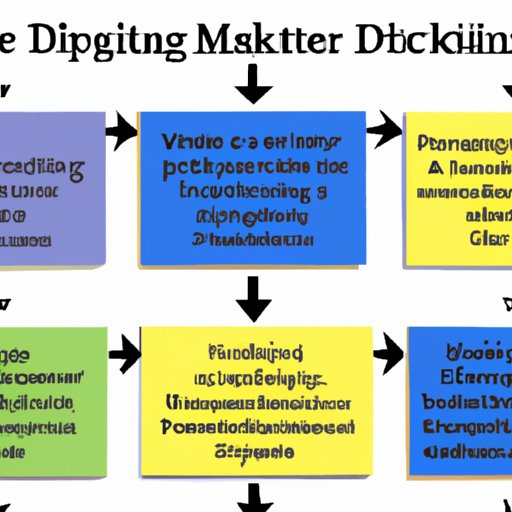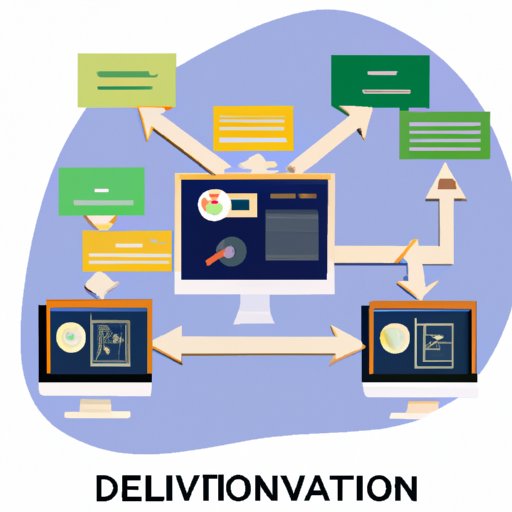Introduction
Decision making is an essential skill for success in life, whether it be on a personal or professional level. Knowing how to make effective decisions is key to reaching desired goals and outcomes. The decision-making process involves a number of steps that help guide you through the process of reaching a conclusion. In this article, we will explore the six steps of the decision-making process and provide tips for improving your decision-making skills.

Overview of the Six Steps in the Decision Making Process
The six steps of the decision-making process are: identify the problem, gather information, evaluate alternatives, make a decision, implement the decision, and monitor and adjust. Each step is essential for reaching an optimal outcome and should be taken seriously. Let’s take a look at each step in more detail.

Exploring Each Step in the Decision Making Process
The first step in the decision-making process is to identify the problem. This is the most important step as it sets the stage for the rest of the process. It is important to take the time to thoroughly understand the issue at hand in order to effectively solve it. Once the problem has been identified, the next step is to gather information. This involves researching the issue, gathering opinions from experts and stakeholders, and analyzing the facts. This is an important step as it helps you to make informed decisions based on the evidence.
The third step in the decision-making process is to evaluate alternatives. This involves looking at the various options available and assessing which one best fits the criteria for the problem. It is important to consider all possible solutions and weigh their pros and cons before making a final decision. The fourth step is to make a decision. This requires taking all the information gathered and making a final choice. It is important to have confidence in your decision and trust that it is the best option.
The fifth step in the decision-making process is to implement the decision. This involves putting the plan into action and ensuring that it is carried out correctly. It is important to take the necessary steps to ensure that the decision is implemented properly. The final step is to monitor and adjust. This involves checking in on the progress of the decision and making any necessary changes if needed. This step helps to ensure that the decision is still the best option and is being implemented correctly.

Analyzing the Pros and Cons of Each Step
Each step in the decision-making process has its own advantages and disadvantages. Identifying the problem is the most important step and can help to avoid costly mistakes. Gather information helps to ensure that decisions are based on fact rather than opinion. Evaluating alternatives helps to narrow down the choices to the best option. Making a decision requires confidence and trust in your own judgment. Implementing the decision ensures that the plan is put into action correctly. Lastly, monitoring and adjusting helps to ensure that the decision is still the best option.
Examining Real-World Examples of the Six Steps
Let’s examine some real-world examples of the six steps in the decision-making process. For example, if a company is considering launching a new product line, the first step would be to identify the problem. This could involve researching the market, understanding customer needs, and determining the viability of the product. The second step would be to gather information, such as competitor pricing, customer feedback, and industry trends. The third step would be to evaluate alternatives, such as different pricing models, distribution channels, and marketing strategies. The fourth step would be to make a decision, such as which pricing model to use and which distribution channels to utilize. The fifth step would be to implement the decision, such as creating a launch plan and setting up the necessary infrastructure. Finally, the sixth step would be to monitor and adjust, such as tracking sales and customer feedback and making any necessary changes.
Comparing and Contrasting Different Approaches to the Decision Making Process
There are two main approaches to the decision-making process: traditional and modern. Traditional decision making utilizes a linear process, where each step is completed in sequence. Modern decision making is more flexible and involves iterative processes, where steps are repeated as needed. Another way to distinguish between different approaches is to compare rational versus intuitive decision making. Rational decision making relies on facts and data, while intuitive decision making relies on instinct and experience.
Tips for Improving Your Decision Making Skills
Improving your decision-making skills can help you reach your goals more efficiently. Here are some tips for improving your decision-making skills: take time to reflect on the situation and consider all angles; consider multiple perspectives, such as those of experts and stakeholders; and be open to change if the situation calls for it. Taking the time to practice and hone your decision-making skills can help you make better decisions and achieve desired outcomes.
Conclusion
The decision-making process involves six essential steps: identifying the problem, gathering information, evaluating alternatives, making a decision, implementing the decision, and monitoring and adjusting. Each step plays an important role in reaching an optimal outcome. Examining real-world examples of the decision-making process can help to provide a better understanding of the process. Additionally, understanding the differences between traditional and modern approaches and the benefits of rational versus intuitive decision making can help to improve your decision-making skills. Taking the time to practice and hone your decision-making skills can lead to better decisions and improved outcomes.
(Note: Is this article not meeting your expectations? Do you have knowledge or insights to share? Unlock new opportunities and expand your reach by joining our authors team. Click Registration to join us and share your expertise with our readers.)
